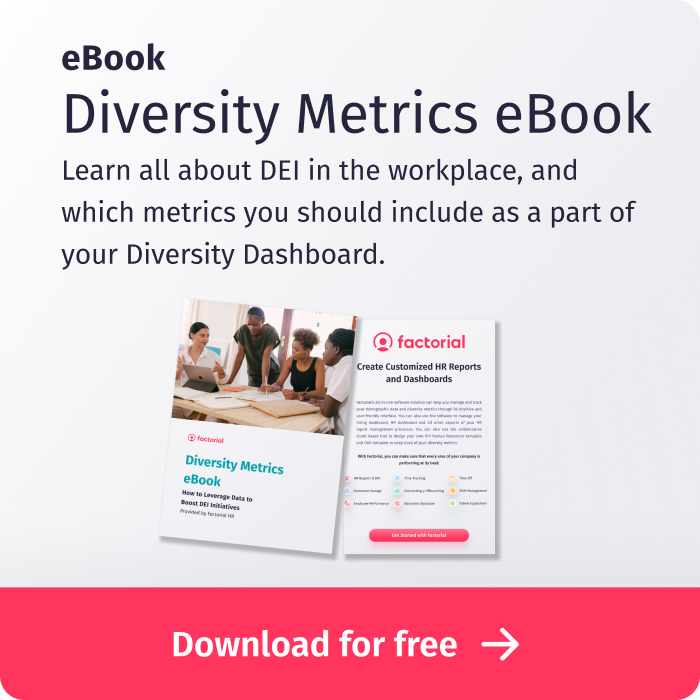Having a diverse, inclusive, and equitable work environment means having a well-balanced and healthy environment. To recruit top talent and reach new markets, it’s essential to have the right business practices and DEI technology.
The business case for investing in DEI is strong. According to McKinsey’s Diversity wins report, progress on executive team diversity continues to be slow even though 36% of ethnically diverse companies and 25% of gender-diverse companies financially outperform their competitors. Another report suggests that 39% of job applicants take inclusiveness into account when making career decisions.
When used correctly, technology can be a valuable instrument for measuring the effectiveness of your DEI teams’ efforts and mitigating unconscious bias.
But what kinds of DEI tech do organizations use? And what are the specific benefits for organizations? In this article, we’ll explore these questions and give you a better understanding of specific DEI technology and features.
The intersection of DEI and technology
There are numerous ways that companies are leveraging technology to promote DEI. However, generally speaking, technology tends to intersect with DEI in two important areas:
Firstly, DEI technology can improve people management practices. There are many kinds of tools that enable users to improve DEI practices across the employee cycle. Think talent acquisition tools or tools that help employers make promotion decisions. A company might use this technology to help them monitor their hiring processes, promote inclusivity while sourcing candidates, and create a more diverse talent pool.
Secondly, DEI tech can improve company culture and the employee experience. For example, many organizations use technology to provide employees with anonymous satisfaction surveys. Feedback tools in particular can encourage employees to speak up about microaggressions, unfair practices, and workplace bullying. These tools lead to increased psychological safety, which ultimately promotes employee engagement and fosters feelings of belonging.
5 ways tech boosts DEI efforts
From reducing bias in the hiring process to implementing equitable pay practices, there are many ways to use DEI technology. In this section, we’ll take a look a look at some of the specific benefits for companies that choose to use DEI technology to support their practices.
Bias visibility
Unconscious bias, also known as “implicit bias”, deals with the underlying messages and attitudes that are expressed toward certain groups of employees. These sentiments are often subconscious and have a major impact on decisions that are made at various points of the employee cycle.
Without recognizing and minimizing unconscious bias, DEI efforts can feel insincere and even hypocritical. For example, organizations that rewrite their mission statement but make very little effort to recruit and promote members of underrepresented communities. For real organizational change to occur, there needs to be a change in mentalities and objectives. And in many instances, these changes need to come from the top down.
However, for many organizations, the subtleties and nuances of unconscious bias can be difficult to see. In these cases, technology can provide companies with a more objective point of view and ultimately help them to take bias out of the decision-making process.
Collecting diversity data
Part of ensuring fair and equitable business practices is collecting and measuring employee data. This especially comes into play while drafting new company policies, conducting regular pay analyses, and adjusting recruitment efforts.
With a DEI dashboard, you can visualize metrics like turnover, retention, and eNPS, to see if there are any differences based on an employee’s race, gender, or age. Additionally, you can measure metrics as compared to:
- Nationality
- Neurodiversity
- Skill sets
Having an up-to-date employee dashboard allows you to identify and address problematic practices in your company. Also, it gives you actionable insights so that you can make strategic decisions worthwhile.
Measure change
Aside from recognizing issues, using DEI technology can help you to implement change and measure the impact of your efforts. In many cases, data is more than just numbers, it tells a story and is a reflection of communication and business practices.
For example, you notice on your dashboard that there is a problem retaining female employees who work in a specific department. Based on this information, it might be worth examining management practices, the language used during meetings, and the opportunities for advancement that are granted to male vs. female employees.
In addition to implementing changes, tools like a DEI dashboard can help you to keep records and fine-tune processes that are already in effect. Let’s say that you have set DEI objectives and have made some significant changes to company policies as a result.
With systems that have automated reporting features, like Factorial you can generate custom progress reports for a given timeframe. That’s to say, you can generate monthly reports with metrics like employee attendance, turnover, and pay rate according to gender, race, or nationality. After tracking these metrics over a set period, you can get a better understanding of which policies impact your team and why.
Improve inclusive recruiting
According to the Harvard Business Review, 85-97% of professionals rely on intuition or mental synthesis of information while hiring new employees. While intuition might feel like a good way of making sure that a new employee is a good cultural fit, it is often not the best strategy.
This is largely because humans are susceptible to unconscious bias while making decisions. As a result, hiring managers relying purely on intuition might feel compelled to select a candidate that is not the most qualified for the role. In fact, the same report suggests that talent acquisition technology is 25% more likely to outperform humans while selecting the right candidate.
That’s not to say that technology is a replacement for a talented recruiter with years of experience. Rather, it can be more of an aid for businesses to remove distraction and bias when narrowing down candidates.
For organizations to make the fairest and most accurate hiring decisions, and to have the best diversity and inclusion recruitment practices, it’s best to use a combination of human and machine decision-making power. Here’s one way to include DEI technology as a part of the recruitment and selection process:
- Use an applicant tracking system to initially filter out qualified candidates based on applications.
- Have an experienced hiring manager interview and collect additional information from top candidates.
- Form a hiring committee consisting of the candidate’s potential manager(s) and coworkers. That way, their input is factored into the hiring process.
- Make a collaborative decision based on a combination of data and the candidate’s interview questions.
Ensure pay equity
Beyond recruitment and selection, attracting and retaining diverse staff means ensuring that your company’s core processes are equitable. Another way that DEI technology can help to make meaningful structural change is by promoting pay transparency and equity.
Pay transparency fosters a trusting and open work environment. And for this reason, it’s advantageous for businesses to disclose salaries to job seekers and existing staff. Otherwise, workers might assume that their pay isn’t reflective of their experience and qualifications. It’s best to be upfront and out in the open about salaries and pay practices.
With DEI technology, you can easily calculate estimated salary ranges, based on your existing employee data. Using this information, you can then benchmark your company’s pay practices and make sure that your salaries are competitive.
To make your promotion practices more transparent and equitable, DEI tech can help to conduct a pay equity analysis of your entire company. Additionally, you can leverage DEI technology to generate a career path/progression chart for every role in your company. Not only will it lead to fairer pay practices, but also provide your staff with tangible career goals. They will have a clear understanding of expectations, and what is necessary to get from point A to point B. Ultimately, this will boost motivation levels and reduce pay-related tensions between staff.
Conclusion
Diversity in your organization means diversity of thought and perspective. Prioritizing DEI means making ethically responsible decisions and helping all employees develop a successful career path. Backing up your initiatives with DEI tech can help you to open up opportunities for your employees and your company as a whole.
Unlike humans, DEI technology used in recruitment tools and HRIS systems lacks unconscious bias in the decision-making process. Therefore, they have the potential to give historically underrepresented groups a fair chance and make progress toward pay equity. While there are many types of DEI technology available, the most effective tools offer the following features:
- Analytical tools to filter and compare employee data with specific KPIs, like turnover, retention, absenteeism, and eNPS scores.
- Automated survey tools that allow you to generate and send anonymous questionnaires.
- Custom reporting features that help you to visualize DEI targets and progress towards business goals.
- Pay reporting tools that help you to track and easily manage employee payslips and salaries.
Prioritizing your diversity, equity, and inclusivity initiatives means prioritizing the well-being of your team. And Factorial has the right tools to get you started. Don’t hesitate, book a free demo now.


